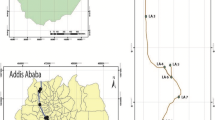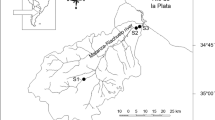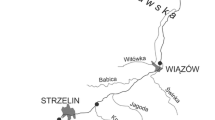Abstract
Wetlands systems generally are considered as filters, retaining allochthonous metals that can have toxic effects on biota. We investigated patterns of spatial variability in trace metal concentrations in sediments and tissues ofPhragmites australis in the marshes of the Danube Delta, Romania in 1993 and 1994. Mean concentrations (±s.e) of Ni, Cr, and Pb in roots were 10.0±0.7, 2.7±0.2, and 11.3±0.5 μg g−1 dry wt, respectively, and in leaves were 0.3 ± 0.1, 0.1 ±0.0, 0.2 ± 0.0 μg g−1 dry wt, respectively. Mean concentrations (± s.e.) of Ni, Cr, Zn, and Cu extracted (0.5M HCl) from sediments were 16.4 ± 0.8, 3.0 ± 0.2, 45.4 ± 1.7, and 29.2 ± 2.3 μg g−1 dry wt, respectively. Sediment metal concentrations decreased significantly (p < 0.01) with distance from the Delta origin, but concentrations in roots and sediments did not vary with distance into the marsh from lake edges nor with distance from main river channels in the Delta. Concentrations of extractable metals from marsh sediments were not correlated to concentrations in roots, suggesting that factors other than labile concentrations in sediments control metal uptake and storage in roots.
Similar content being viewed by others
Literatur Cited
Agemian, H. and A.S.Y. Chau. 1977. A study of different analytical extraction methods for nondetrital heavy metals in aquatic sediments. Archives of Environmental Contamination and Toxicology 6:69–82.
Calmano, W. and U. Förstner. 1983. Chemical extraction of heavy metals in polluted river sediments in central Europe. Science of the Total Environment 28:77–90.
Campbell, P.G.C., A.G. Lewis, P.M. Chapman, A.A. Crowder, W.K. Fletcher, B. Imber, S.N. Luoma, P.M. Stokes, and M. Winfrey. 1988. Biologically Available Metals in Sediments. National Research Council Canada, Ottawa, Canada. Vol. NRCC No. 27694.
Chester, R., W.M. Kudoja, A. Thomas, and J. Towner. 1985. Pollution reconnaissance in stream sediments using non-residual trace metals. Environmental Pollution (Series B) 10:213–238.
Chiu, C.-Y. and C.-H. Chou. 1991. The distribution and influence of heavy metals in mangrove forests of the Tamshui Estuary in Taiwan. Soil Science and Plant Nutrition 37:659–669.
Deely, J.M., J.C. Tunnicliff, C.J. Orange, and W.H.L. Edgerley. 1992. Heavy metals in surface sediments of Waiwhetu Stream, Lower Hutt, New Zealand. New Zealand Journal of Marine and Freshwater Research 26:417–427.
Duinker, J.C. and R.F. Nolting. 1978. Mixing, removal and mobilization of trace metals in the Rhine estuary. Netherlands Journal of Sea Research 12:205–223.
Dunbabin, J.S. and K.H. Bowner. 1992. Potential use of constructed wetlands for treatment of industrial wastewaters containing metals. The Science of the Total Environment 111:151–168.
Försther, U., W. Ahlf, and W. Calmano. 1989. Studies on the transfer of heavy metals between sedimentary phases with a multi-chamber device: combined effects of salinity and redox variation. Marine Chemistry 28:145–158.
Franzin, W.G. and G.A. MacFarlane. 1980. An analysis of the aquatic macrophyte,Myriophyllum exalbescens, as an indicator of metal contamination of aquatic ecosystems near a base metal smelter. Bulletin of Environmental Contamination and Toxicology 24:597–605.
Gambrell, R.P. and W.H. Patrick, Jr. 1988. The influence of redox potential on the environmental chemistry of contaminants in soils and sediments. p. 319–333.In D.D. Hook, W.H. McKee, Jr., H.K. Smith, J. Gregory, V.G. Burrell, Jr., M.R. DeVoe, R.G. Sojka, F. Gilbert, R. Banks, L.H. Stolzy, C. Brooks, T.D. Matthews, and T.H. Scear (eds.) The Ecology and Management of Wetlands. 1. Ecology of Wetlands. Croom Helm, London, UK.
Giblin, A.E., A. Bourg, I. Valiela, and J.M. Teal. 1980. Uptake and losses of heavy metals in sewage sludge by a New England salt marsh. American Journal of Botany 67:1059–1068.
Gries, C. and D. Garbe. 1989. Biomass, and nitrogen, phosphorus and heavy metal content ofPhragmites australis during the third growing season in a root zone waste water treatment. Archiv für Hydrobiologie 117:97–105.
Hall, W.S. and G.W. Pulliam. 1995. An assessment of metals in an estuarine wetlands ecosystem. Archives of Environmental Contamination and Toxicology 29:164–173.
Hart, B.T.. 1982. Uptake of trace metals by sediments and suspended particulates: a review. Hydrobiologia 91:299–313.
Hook, D.D. 1993. Wetlands: history, current status, and future. Environmental Toxicology and Chemistry 12:2157–2166.
IUCN. 1991. Draft Report. Conservation status of the Danube Delta, IUCN Mission September 17–27 1990. IUCN—The World Conservation Union, Tulcea, Romania.
Kabata-Pendias, A. and H. Pendias, 1984. Tracè Elements in Soils and Plants. CRC Press, Boca Raton, FL, USA.
Lacerda, L.D., M.A. Fernandez, C.F. Calazans, and K.F. Tanizaki. 1992. Bioavailability of heavy metals in sediments of two coastal lagoons in Rio de Janeiro, Brazil. Hydrobiologia 228:65–70.
Lan, C., G. Chen, L. Li, and M.H. Wong. 1992. Use of cattails in treating wastewater from a Pb/Zn mine. Environmental Management 16:75–80.
Linnik, P.N., N.N. Osadchaya, B.Yu.B. Nabivanets, and N.Yu. Evtushenko. 1994. Evaluation of the physicochemical state of heavy metals in Danube water in various stretches. Water Resources 20:48–55.
Litherathy, P., F. Laszlo, and B. Csanyi, 1994. Approaches for sediment associated pollutant monitoring in the river Danube. Water Science and Technology 30:157–165.
Mudroch, A. and J.A. Capobianco. 1979. Effects of mine effluent on uptake of Co, Ni, Cu, As, Zn, Cd, Cr, and Pb by aquatic macrophytes. Hydrobiologia 64:223–231.
Muller, B. and L. Sigg. 1990. Interaction of trace metals with natural particle surfaces: Comparison between adsorption experiments and field measurements. Aquatic Sciences 52:75–92.
Nebesnyy, V.B., D.V. Dubyna, V.F. Prokopenko, and Y.R. Shelyag-Sosonko 1993. Distribution of heavy metals accumulated inPhragmites australis in delta zones of the northern Black Sea coast. Hydrobiological Journal 29:9–21.
Oertel, N. 1991. Heavy-metal accumulation inCladophora glomerata (L.) Kutz in the River Danube. Ambio 20:264–268.
Oertel, N. 1996. Plants and animals as biomonitors of heavy metal level in the aquatic ecosystem of the river Danube. Archives of Toxicology (Supplement) 18:404–416.
Paalman, M.A.A. and C.H.V.d. Weijden. 1992. Trace metals in suspended matter from the Rhine/Meuse estuary. Netherlands Journal of Sea Research 29:311–321.
Pip, E. and J. Stepaniuk. 1992. Cadmium, copper and lead in sediments and aquatic macrophytes in the Lower Nelson River system, Manitoba, Canada I. Interspecific differences and macrophytesediment relations. Archiv für Hydrobiologie 124:337–355.
Rendell, P.S., G.E. Batley, and A.J. Cameron. 1980. Adsorption as a control of metal concentrations in sediment extracts. Environmental Science and Technology 14:314–318.
SAS. 1989. SAS Software Release 6.11. SAS Institute Inc. Cary, NC, USA.
Schierup, H.-H. and V.J. Larsen. 1981. Macrophyte-cycling of zinc, copper, lead and cadmium in the littoral zone of a polluted and a non-polluted lake. I. Availability, uptake and translocation of heavy metals inPhragmites australis (Cav.), Trin. Aquatic Botany 11:197–210.
Simpson, R.L., R.E. Good, R. Walker, and B.R. Frasco. 1983. The role of Delaware River freshwater tidal wetlands in the retention of nutrients and heavy metals. Journal of Environmental Quality 12:41–48.
Sinicrope, T.L., R. Langis, R.M. Gersberg, M.J. Busnardo, and J.B. Zedler. 1992. Metal removal by wetland mesocosms subjected to different hydroperiods. Ecological Engineering 1:309–322.
St-Cyr, L. and P.G.C. Campbell. 1994. Trace metals in submerged plants of the St. Lawrence River. Canadian Journal of Botany 72:429–439.
St-Cyr, L. and A.A. Crowder. 1988. Iron oxide deposits on the roots ofPhragmites australis related to the iron bound to carbonates in the soil. Journal of Plant Nutrition 11:1253–1261.
Taylor, G.J. and A.A. Crowder. 1983. Uptake and accumulation of heavy metals byTypha latifolia in wetlands of the Sudbury, Ontario region. Canadian Journal of Botany 61:63–73.
Teal, J.M., A. Giblin, and I. Valiela. 1982. The fate of pollutants in Americal salt marshes. p. 357–366.In B. Gopal, R.E. Turner, R.G. Wetzel, and D.F. Whigham (eds.) Wetlands: Ecology and Management, Proceedings of the First International Wetlands Conference, New Delhi, India. 10–17 Sept. 1980. National Institute of Ecology and International Scientific Publishers, Jaipur, India.
Valerio, F., C. Brescianini, S. Lastraioli, and S. Coccia. 1989. Metals in leaves as indicators of atmospheric pollution in urban areas. International Journal of Environmental and Analytical Chemistry 37:245–251.
Van Valin, R. and J.W. Morse. 1982. An investigation of methods commonly used for the selective removal and characterization of trace metals in sediments. Marine Chemistry 11:535–564.
Wallace, A. and E.M. Romney. 1977. Roots of higher plants as a barrier to translocation of some metals to shoots of plants. p. 370–379.In Biological Implications of Metals in the Environment: Proceedings of the Fifteenth Annual Hanford Life Sciences Symposium at Richland, Washington, Sept. 29–Oct. 1, 1975. Technological Information Center, Energy Research and Development Administration, Oak Ridge, TN, USA.
Wells, J.R., P.B. Kaufman, and J.D. Jones. 1980. Heavy metal contents in some macrophytes from Saginaw Bay (Lake Huron, U.S.A.). Aquatic Botany 9:185–193.
Whitton, B.A., I.G. Burrows, and M.G. Kelly. 1989. Use ofCladophora glomerata to monitor heavy metals in rivers. Journal of Applied Phycology 1:293–299.
Zwolsman, J.J.G., G.W. Berger, and G.T.M.V. Eck. 1993. Sediment accumulation rates, historical input, postdepositional mobility and retention of major elements and trace metals in salt marsh sediments of the Scheldt estuary, SW Netherlands. Marine Chemistry 44:73–94.
Author information
Authors and Affiliations
Rights and permissions
About this article
Cite this article
Keller, B.E.M., Lajtha, K. & Cristofor, S. Trace metal concentrations in the sediments and plants of the Danube Delta, Romania. Wetlands 18, 42–50 (1998). https://doi.org/10.1007/BF03161441
Received:
Revised:
Accepted:
Issue Date:
DOI: https://doi.org/10.1007/BF03161441




